

Looking for something good to eat
February 8-21, 2003
What better fall back for the two of us than food. And Mumbai seems like the perfect place to start. As one of India's largest cities there are plenty of restaurants representing food from many different regions. Our biggest problem is having too many options, some better, some worse, and we just cannot always tell the difference. So we embark on a quest to find someone who can guide us through the food maze of India.
A funny thing about quests is that they do not always yield the desired result. This holds especially true in India where a simple search for caribiners and swivel hooks (don't ask) started in hardware stores, took me through two large markets, from stationary store to stationary store, finally yielding some success at a costume jewelery store (again, don't ask). Our food-quest follows a similar path.
We arrive in Mumbai (formerly Bombay) at the obscene hour of 3:30 am. For a variety of reasons our time here will be long, almost two weeks. So the big question is how to keep ourselves entertained. There is plenty to do around town between temples, bazaars, updating the website and just taking in the streets. But given our long time in one place we decide to add a little structure to take something more away.
We launch our search with a two-pronged approach. First we e-mail the food critics from the local papers and wait for a response. While waiting we check in with our fellow travelers on Lonely Planet's Thorntree. This yields a little information, along with some tantalizing clues for the next step. The information improves slightly when we clarify that the guide we seek is a person, not a book, and even get some offers by locals who check the Thorntree to be our guide. While none of these offers pan out (let's just say "background checks") some of the other information proves invaluable, especially a list of restaurants and the names of two women who are widely regarded as India's native food experts. In spite of our best efforts, including trips all over town to find associated stores, we never establish contact with either woman.
While waiting to hear back from the food critics we content ourselves with self-education at Mumbai's plentiful restaurants. Two notable experiences occurred at opposite ends of the cost spectrum. The first is Khyber, in the heart of Kala Ghoda. The walls are covered in murals in ancient style and stone reliefs decorate the lintels and pillars. The menus, encased in huge, carved wood bindings, offer an astounding range of wonderful sounding dishes. Tempted, as we frequently are, to order more then we should eat (all in the name of research) we limit ourselves to two dishes and some tandoori bread. Khyber raan, their signature lamb dish, is excellent. Tender, succulent, rich and flavorful. Marinated for days it is a real treat. But topping that complexity is a simple tandoori gobi, cauliflower, heavily seasoned and baked on skewers in the high heat of a clay oven. It is perfectly tender throughout and the seasonings enhance the light flavor of the underlying vegetable. This is what we had been looking for, albeit at a high price (by Indian standards).

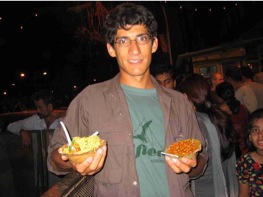
After a few days we get our first (and only) response from a food critic. Ram is a self-described foodie and most of his reviews seem to be of earthier places, perfect for Amy and I. He agrees to meet us so we arrange an appointment for lunch. Unfortunately on the day of our appointment Amy's stomach is not well (occupational hazard) and the last thing she wants to do is talk about food. So, I venture out alone.
Ram shows up on time, looking rushed and a little distracted. But he has an energy and passion which rapidly become apparent. I should have figured it out before the meeting since the two most recent reviews by Ram were of a television show and a movie, but Ram loves Bollywood. In fact, in a few weeks he would leave his writer's post at the Midday (newspaper) to work on what he described as "his new TV show." He is even working on a book about ordinary, but strange people around India, as well as several scripts for movies. With that introduction you can imagine the conversation had little to do with food. Ram talked about Indian television and movies as well as his life.
Married with a child on the way, he lives with his parents in a 300 square foot house. With his new found success the family will soon be upgrading, only to 450 square feet (real estate prices being what they

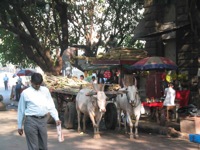

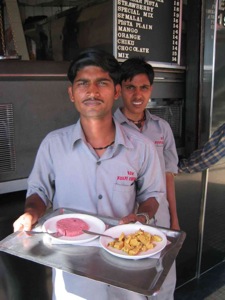
Moving to the cheapest of the cheap we eat several meals at the famous, long-lasting Bade Miya food stall, literally in the shadow of the luxurious Taj Mahal Hotel. The small portions and multiple visits allow us to sample most of their dishes, which are cooked out in the open on huge gas fired plates. The bread is thin, perfect for gripping the tender, but rustically seasoned, chicken tikka and keeping the hands grease free. The boti roll, basically an omlette wrapped inside roti, is a rich addition, especially when dipped in their full flavored hot sauce. Adding zest to the food is the boisterous, late night atmosphere, all in a back alley. Some of the surrounding streets are pretty rough, but Bade Miya attracts people from all over the city, providing a measure of security.
are in Mumbai). I do get a few food tidbits from him, but his energy is obviously focused elsewhere. The information he gives is watered down based on his (mis)perceptions of what a Western tourist wants. While he loves to eat food he does not have any depth of understanding about India's food culture. His interests and strengths lie in people and keeping them entertained.
In the end the simplest advice we got from the Thorntree proved the most useful: Explore on your own and ask lots of questions.
--Z

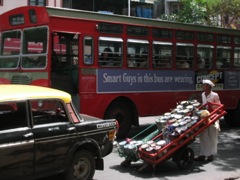



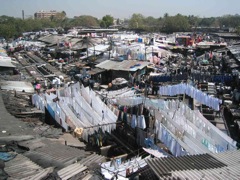
Lunch delivered to your door.
Mahalaxmi Dhobi Ghats.
Taj Mahal Hotel.
Photographs and Text: Copyright 2002 & 2003, Zachary Maler & Amy Leffert